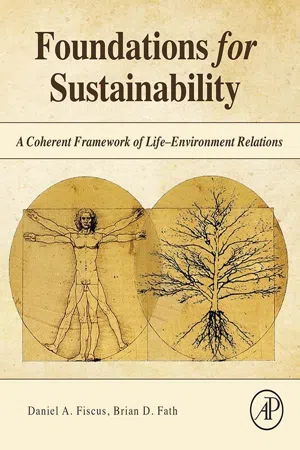
Foundations for Sustainability
A Coherent Framework of Life–Environment Relations
- 292 pages
- English
- ePUB (mobile friendly)
- Available on iOS & Android
Foundations for Sustainability
A Coherent Framework of Life–Environment Relations
About This Book
Foundations for Sustainability: A Coherent Framework of Life-Environment Relations challenges existing assumptions on environmental issues and lays the groundwork for a new paradigm, bringing a greater understanding of what is needed to help create an environmentally and economically sustainable future, which to date has been an uphill battle and not an obvious choice. The book presents the case for a paradigm based on a multi-model of life as organism, life as ecosystem, and life as biosphere, as opposed to the singular assumption that life can be viewed solely as an organism.
All backed with well-cited research from top investigators from around the world, this book is a must-have resource for anyone working in ecology, environmental science or sustainability.
- Introduces a holistic, systemic approach and a synthesis of the systemic root cause that underlies many surface symptoms that are part of individual environmental problems (climate, water, energy, etc.)
- Complements current piecemeal approaches in order to solve many interconnected environmental problems which share root causes
- Provides tests and thought experiments to challenge current views on sustainability, leveraging the power of critical thinking to find new solutions
- Gives insights on how to find solutions by blending interdisciplinary and transdisciplinary focuses with disciplinary specialization in ecology and ecosystem science
- Bridges concepts and methods from math to ecology to human development
Frequently asked questions
Information
To solve a difficult problem, enlarge it
Abstract
Keywords
Introduction
- 1. Balances and synergizes holism with reductionism;
- 2. Equally emphasizes internalist and self-referential as well as objectivist perspectives;
- 3. Is anticipatory and accelerates the pace and process of paradigm shifts; and
- 4. Is consciously, intentionally, and transparently value-based centered on the value of life.
1. Soil loss and degradation 2. Unprecedented land use change and conversion of natural habitat to human dominated landscapes 3. Rates of species extinctions on par with the five mass extinctions of all time 4. Plateau of food production and increasing vulnerability of the food supply 5. Disruption of the global nitrogen cycle 6. Pressure related to fossil-fuel dependency (including conflicts over pipelines, fracking, and more) 7. Global climate disruption 8. Sea level rise and impacts on coastal areas with dense human population 9. Ocean acidification and related disruption to coral reefs and ecosystems 10. Water pollution and shortages in many areas 11. Persistent and bioaccumulating toxins and solid waste such as plastic and micro-plastics |

- A. A paradigm in science is promulgated via education, technology, and media to most people in industrial culture. It is the assumed and shared normative system of ideas, specifically with respect to life and environment. In this science paradigm, life is separated from environment thus severing the unity of life and life-support systems conceptually and scientifically.
- B. Following the scientific paradigm, inherent in the cultural system of ideas, life is separated from environment in mind and action. This is the key error (or outdated paradigm) that severs the unity of life and life-support systems in the real world.
- C. Once fragmented, it is possible and likely that the value of environment is seen and treated as less than the value of life. Note that it is not possible for this relative devaluation of environment to occur if life–environment remains unified as a single focal entity and system of study. This follows from the revised paradigm we present here.
- D. Individuals act for self-interest primarily and compete for what they perceive as limited, scarce, and zero-sum resources and assume that environment degradation is normal, expected, inevitable, and acceptable.
- E. Environment is consumed and degraded as manifest in many symptoms of ecological crisis, and the influence of the citizens’ mental fragmentation and devaluation of environment travels upward to larger scales and produces the global crisis.
The Reality of Win–Win
Table of contents
- Cover image
- Title page
- Table of Contents
- Copyright
- Dedication
- List of Figures
- List of Tables
- Preface
- Reviews
- Acknowledgments
- Chapter 1. To solve a difficult problem, enlarge it
- Chapter 2. Life as the basis of value
- Chapter 3. Holistic science of life–environment – mutualistic interfaces
- Chapter 4. Life: From origins to humans
- Chapter 5. Reforming reductionism with six core principles
- Chapter 6. Life science lessons from ecological networks and systems ecology
- Chapter 7. A bridge not too far: Spanning theory to science to application
- Chapter 8. Technology and applications in the context of holistic life–environment
- Chapter 9. Sustainability: A goal for all
- Bibliography
- Index
